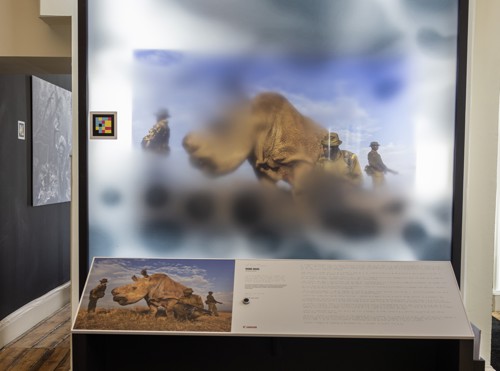Featuring tactile high-relief prints of famous photographs, alongside braille and audio descriptions, the exhibition is designed specifically to welcome blind and partially-sighted visitors to a space – an art gallery – where they often face barriers.
Printed entirely on Canon’s Arizona 2300 series by Prosign in Nottingham, the show also features large-scale prints obscured by translucent filters to mimic eye disorders such as diabetic retinopathy or age-related macular degeneration, helping full-sighted visitors understand how their peers experience the visual world.
“This is lightyears ahead of where we’ve been so far. It’s groundbreaking,” said Lawrence Gunther, a marine ecologist who was registered blind at age eight.
“When I heard about this technology, I had no idea – I honestly thought it was going to be some sort of 3D printing. But when I put my hand on the picture, I actually felt the texture of the rhinoceros’ skin – it’s as close as blind people are going to come to seeing with their fingers.”

Gunther pointed out that the low-relief technique, where layers of pigment are digitally printed in microscopic layers, allows both blind and sighted to enjoy the same piece, bringing people together in their enjoyment.
“With just two or three milimetres of built-up medium – I’m told the beauty of the picture is still there, so it’s still accessible [visually] to the sighted. But I’ve been involved in tactile technology and accessibility for the blind, and this is just groundbreaking.”
Prosign printed the relief prints using Canon’s Prisma Elevate XL software, that automatically recognises colour gradations and assigns them different elevations of relief before printing.
Mathew Faulkner, Canon’s head of marketing and innovation for wide-format, told Printweek: “I’ve been involved in print for 30 years, but this is easily one of the most amazing projects I’ve worked on.
“Naturally, I love printing – but to me, this shows the real power of print. We know it can be beautiful, create great environments, but to me this is a whole other level. It’s print communicating in a whole new way.”
The show, open to the public from 5-7 April, was developed over several months in cooperation with the Royal National Institute of Blind People (RNIB) and Dutch braille specialists CBB.
“The RNIB and CBB have been amazing at helping us, and it has been a great learning process for us to really understand the best way to communicate through sound, braille and touch,” Faulkner said.
Dave Williams, inclusive design ambassador at the RNIB, added: “Exhibitions like this really tackle attitudinal and information barriers [for blind people]. Why shouldn’t we make a photography exhibition?
“Touch is such an important part of the human experience – we all remember not being able to touch one another in the pandemic, shake peoples’ hands – it is such a fundamental part of all our experiences.
“Absolutely, it is about improving the experience for blind and partially sighted people, but also about doing that for sighted people, too.”
The World Unseen remains at Somerset House until 7 April, after which it will travel around Canon’s European hubs.








